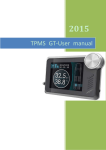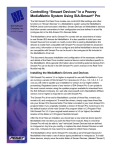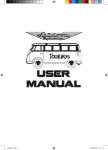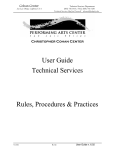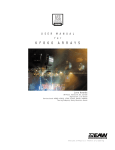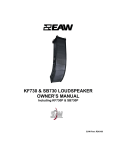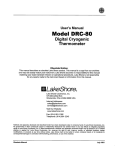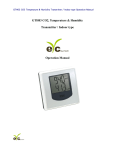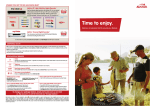Download Operating Instructions
Transcript
® BedRoom ® GreenRoom Remember to visit www.JamHub.com/community/forum for the latest news and updates, and to join our growing community of musicians. You can learn more about your JamHub at www.YouTube.com/HubHed. Find our Facebook fan page link on the www.JamHub.com homepage or by searching for “JamHub” in Facebook. TourBus Owner’s Manual JamHub® Silent Rehearsal Studio Safety Guide Owner’s Manual Introduction This Safety Guide contains important safety and handling information for JamHub. Thanks for buying the JamHub® silent rehearsal studio. And congratulations because now you and your band can jam anywhere, anytime without disturbing the peace. Read all safety information below and operating instructions before using JamHub to avoid injury. For detailed operating instructions, see the User Guide that follows this Safety Guide. WARNING: Failure to follow these safety instructions could result in fire, electric shock, or other injury or damage. Handling JamHub and Using Power Supply Cord Do not bend, drop, crush, puncture, incinerate or open JamHub. Power supply cords should be routed so that they are not likely to be walked on or pinched by items placed upon or against them. Water and Moisture JamHub should not be used near water (e.g. near a bathtub, washbowl, kitchen sink, laundry tub, in a wet basement, or near a swimming pool, etc.). Do not use JamHub in rain. Take care not to spill any food or liquid into or onto JamHub. Non-use Periods The power cord of the JamHub should be unplugged from the outlet when left unused for a long period of time. Use of Power Adapter The JamHub Power Adapter may become warm during normal use. Always allow adequate ventilation around the JamHub Power Adapter and use care when handling. Unplug the JamHub Power Adapter if any of the following conditions exist: • The power cord or plug has become frayed or damaged. • The adapter is exposed to rain, liquids, or excessive moisture. • The adapter case has become damaged. • You suspect the adapter needs service or repair. • You want to clean the adapter. Avoiding hearing damage Permanent hearing loss may occur if headphones are used at high volume. If you experience ringing in your ears or muffled speech, stop listening and have your hearing checked. The louder the volume, the less time is required before your hearing could be affected. Hearing experts suggest that to protect your hearing you should limit the amount of time you use headphones at high volume. The JamHub team is made up of musicians and non-musicians who are passionate about making great quality products and servicing them well. To learn more about our products or the JamHub story, check out www.JamHub.com. While there, you can connect with other musicians who own JamHubs and the JamHub team, including the inventor. Plus, you’ll learn plenty of tips and tricks for getting the most out of this unique piece of gear. The JamHub team wants to do everything possible to inspire you to play more music, create more music, and have more fun doing it. Isn’t that what being a musician is all about? Owner’s Manual: a new approach Owner’s manuals are funny things. They are often written for (and by) “left brain” analytical types. Yet they most benefit “right brain” creative people who usually disregard them. So we decided to try something different. Since musicians are left and right brain individuals, why not design a manual that satisfies both sides of the brain. So in our manual, from time-to-time, the pages will split like this: Left Brain: analytical, verbal, numeric Right Brain: creative, visual, emotional On this side of the page you’ll find things that are more left brain targeted, like: On this side of the page you’ll find things that are more right brain targeted, like: • Numbers • Feature benefits • Specs • Tips and tricks • Feature descriptions • Comic relief • Technical facts How to make the most of this document Read the JamHub Quick Start Guide twice and you’ll be 90% of the way there. You should thoroughly understand the “Connections” and “Setting the Levels” sections. If you know this stuff well, you’ll always have a great jam session. If you don’t, you could be frustrated at times. All musicians need to understand setting levels. You’ll need it for recording, live performances and for JamHub rehearsals. It’s easy stuff and essential to having a great jam session. So please learn it. Heat and Ventilation JamHub should be situated away from heat sources such as radiators, heat registers, stoves, or other appliances (including amplifiers) that produce heat, and in a manner that allows for proper ventilation. Cleaning JamHub should be cleaned with a soft, damp cloth. Damage requiring service Never attempt to repair JamHub yourself. JamHub does not contain any user-serviceable parts. For service information, go to www.JamHub.com. JamHub should be serviced by qualified service personnel when: • the power cord or the plug has been damaged; or • objects have fallen, or liquid has been spilled into JamHub; or • JamHub has been exposed to rain or moisture; or • J amHub does not appear to operate normally or exhibits a marked change in performance; or • JamHub has been dropped, or the enclosure has been damaged. GreenRoom model shown ® by BreezSong LLC 2 3 JamHub® – What is it? Left Brain: A JamHub is a multi-input, multi-audio channel device designed specifically to allow musicians to jam or rehearse quietly and play more often. This typically leads to improving the band’s skills very rapidly. Scientific studies show that better quality practicing leads to faster skills development. Some say, “Practice doesn’t make perfect, perfect practice makes perfect.” Use your JamHub to make the best rehearsals possible. Simply plug in your practice gear, like a modeling amp, a keyboard, your microphone, and your headphones. Have your band mates do the same. Everyone can create a mix that’s right for them and you’re ready to go. You’ll find with a JamHub that you can play longer, without disturbing others, and without burning out your ears. Most importantly, because there aren’t several loud amps in a small room muddying up the music, the clarity of your jam is greatly enhanced and rehearsals are much more productive. Lastly, with the JamHub’s SoleMix™ controls, you control what you hear. So volume wars are a thing of the past. Bass player too loud? Just reach over to your JamHub section and turn him/her down. And the bass player can turn up the drums and turn down your guitar so he/she can lock into the groove. Everyone hears what they need to hear to ensure the band is improving faster. Table of Contents Left Brain: he Table of Contents below will help guide you T through each section of the manual and get you to things quickly and efficiently. Right Brain: A JamHub lets you jam with your band anywhere, anytime in near silence. And the experience rocks. Each musician picks a color section and plugs in their instruments, microphones and headphones, then, using their section’s SoleMix controls, creates their own perfect mix. You’ll hear yourself with amazing new clarity and no more volume wars. So, not only will you be jamming more often, but you’ll also be getting better faster and working out totally new arrangements to the same old songs. Improving and enjoying your music has never been this easy. Right Brain: The Table of Contents below is probably not necessary because we know you’re just going to flip through the manual until you find the picture you think best answers your question. That’s why we included so many illustrations. Contents Safety Warning............................................................................................................................................... 2 Introduction................................................................................................................................................... 3 a new approach.................................................................................................................................... 3 How to Make the Most of this Document.......................................................................................................... 3 What is it?..................................................................................................................................................... 4 Getting Started: an overview........................................................................................................................... 6 Step 1: turn down knobs................................................................................................................................. 6 Step 2: connections........................................................................................................................................ 7 Step 3: setting trim levels............................................................................................................................... 8 Step 4: using stage control.............................................................................................................................. 8 Step 5: adjusting headphone volume............................................................................................................... 9 Step 6: using the SoleMix™ control section..................................................................................................9,10 Step 7: setting up the SoleMix remote........................................................................................................... 11 SoleMix controls: a closer look...................................................................................................................... 12 What’s up with the “R” section............................................................................................................. 12 Using the 1-R switch........................................................................................................................... 13 Effects engine and settings.................................................................................................................. 13 Guide to the effects engine.................................................................................................................. 14 JamHub Model Comparisons......................................................................................................................... 15 Useful Diagrams.......................................................................................................................................15,16 Hook-up diagrams............................................................................................................................... 15 Ins and Outs diagrams........................................................................................................................ 16 Trim Controls: a detailed review..................................................................................................................... 17 Additional GreenRoom and TourBus Features Phantom Power................................................................................................................................... 17 Additional TourBus Features: Recording......................................................................................................... 18 Menu Structure and Soft Keys.............................................................................................................. 18 Home Menu........................................................................................................................................ 19 Metronome Functions.......................................................................................................................... 19 Utility Menu........................................................................................................................................ 19 Directory............................................................................................................................................ 20 Mark and Delete Mark Functions.......................................................................................................... 20 Summary..................................................................................................................................................... 20 FAQs .............................................................................................................................................21,22 Other things to know........................................................................................................................... 22 Warranty..................................................................................................................................................... 23 4 5 Getting Started SoleMix™ controls Step 2: Connections phantom power LED* effect type selector power LED headphone volume controls headphone jacks mic inputs stage controls mic input trim controls effects return controls instrument input trim controls instrument inputs (stereo) instrument input mic input headphone input 1. Plug in the power adapter. The blue LED light tells you when the JamHub® is ready. R section R section headphone jack instrument jack input trim LEDs R section mic jack 2. Pick a section to call your own. 3. P lug in your instrument with a Stereo (TRS) cable using your instrument’s or amp’s headphone jack for the best results. Often the headphone jack’s output is optimized for headphone listening. 4. Plug in a microphone. 5. Plug in your headphones. SD RAM card slot** *GreeRoom and TourBus models only **TourBus only remote connectors power connector USB connector* phantom power switch* remote connectors 6. Tell your band mates to follow steps 2 through 5. 7. OK, you’re almost ready to rock. But first some very important info: IMPORTANT! Connect your instruments with a stereo instrument cable or stereo adapter! Step 1: Turn down all knobs Stereo Mono 6 Left Brain: Turn all the knobs on the JamHub® to zero (100% counterclockwise) to protect the device and your headphones from grounding and connection pops. Right Brain: Protect your ears and your gear: turn all knobs down on every section of the JamHub before putting on the headphones. Okay, do this NOW. Now that everyone’s connected, a good starting mix is your control at 2:00 and every one else at 12:00. Now that everyone’s connected a good starting mix is your control at 2:00 and every one else at 12:00. When connecting your instrument, it’s important to use a stereo cable, here’s why. Your JamHub is a stereo environment, just like the real world. Because your instrument’s output often includes reverb and other stereo effects, we designed the JamHub to accept a stereo signal and make the listening experience great. If you connect to the JamHub with a mono cable, like a standard guitar cable, your sound will be 100% in the left ear, this is because of the way a mono cable works with a stereo jack. You can use the included mono 1/4” female to stereo 1/4” male adapter if you need to use a mono cable. But we recommend against using this solution in the long run. Audio coming from this “spit mono” signal is not as good as a stereo signal. This is because of the way the human hearing system works. In a live jam, each ear hears something slightly different because of reflections in the room. With “split mono” each ear hears the exact same thing and that reduces our perception of clarity. Therefore “split mono” is not as optimal as a true stereo signal, so we recommend using a stereo signal and a stereo cable. 7 Step 3: Setting the trim levels Step 5: Turn up the headphone volume trim light 1. U se the double knob labeled “trim” to set your input gain (note: you don’t need to put on headphones to do this step). Use the light under the dual trim knobs to set this knob to the right level for your inputs by follwing steps 2 and 3. 2. Speak into the mic and turn the outer/bottom knob up (clockwise) until the LED turns yellow. Then turn it back a little. 3. Play your instrument and turn the inner/top knob up (clockwise) until the LED turns yellow. Then turn it back a little. 4. W atch your trim settings throughout the jam session. Sometimes input levels can change as the band gets warmed up. Use the table below as your guide. In summary Left Brain: green = signal yellow = near clipping (-6dB) red = preamp clipping (+6dB) Right Brain: green = good yellow/orange = caution red = bad Left Brain: Start with the headphone output control at zero (100% counterclockwise) and slowly turn it up. Because every section of the JamHub® has its own individual mix, output adjustments will vary by player. So start low and turn up slowly. Also, headphones have a wide variety of impedances. While your JamHub is designed to handle them all, the setting of each headphone volume knob might be different. Right Brain: Don’t burn out your ears. Bring the volume up s-l-o-w-l-y. Also, while the JamHub does work with most headphones, it can’t make cheap or poor quality ones sound better. Sorry, we’re gear makers not miracle workers. (A plea from the JamHub inventor: Please be careful with your hearing. You’re going to want to keep playing for a long, long time and you’ll want your ears in good working order.) Step 4: Pick a virtual location with the stage control stage for section 3 Left Brain: The stage control is simply a pan or balance control that helps ensure that musicians don’t crowd the mix. Because our hearing system has two receptors separated by about 6 inches (known as your ears) we have the ability to perceive sounds coming from different locations due to slight delays in arrival time. Great audio engineers have known for a long time that by “moving” things to their own sonic location, our hearing system is optimized and we experience greater clarity. There’s a great article on Wikipedia about this amazing property of our hearing system. Read all about it here: stage for section 4 Right Brain: Does everyone in your band stand in the middle of the stage when jamming? Of course not. So spread out sonically with the Stage Control. The experience will be similar to what happens when you’re playing live. You’ll hear things with greater clarity and the jams will be more enjoyable. If you want to understand why great recordings have instruments panned to different locations, read the “left brain” side of this box and the article on Wikipedia mentioned over there. Learning to spread out sonically will help your band get ready for the recording studio as well. http://en.wikipedia.org/wiki/Cocktail_party_effect 8 9 Step 6: Using the SoleMix control section Step 7: SoleMix remote setup All JamHub® models allow you to add a SoleMixTM remote. If you purchased a JamHub GreenRoom or TourBus model, it is included. The BedRoom model has 1 SoleMix remote connector. GreenRoom and TourBus both have 4. If you want to add one or more SoleMix remotes to your JamHub system, they are available at your authorized JamHub dealer. The SoleMix remote lets you create a unique mix for the output jack on the remote. Each remote has its own headphone jack so you can have complete control over your mix and output level with one cable from the JamHub main unit. It is not connected to any specific section because it controls output only. The SoleMix remote was created so that drummers, keyboard players and musicians who are “stuck” behind their gear can make mix changes without moving to the main JamHub unit. The remote acts just like the SoleMix section on the JamHub but without the input section (input trims, jacks and stage control). Below is an illustration of a remote setup option. Left Brain: Each SoleMixTM control section allows you to tap the many stereo busses located within your JamHub®, giving you an exceptional level of control over what each musician hears as their output mix. Want to hear more of the musician in section 3? Turn up the #3 knob. Right Brain: Each SoleMix control section is like an individual mixer. You get to create the mix that’s right for you while the other band members do the same. Think of the JamHub‘s controls as many mixers put together in one portable, affordable unit. Each person controls their own mix and their own creative space. Effects return is located under the headphone volume on each SoleMix section of the JamHub’s main unit. It’s also its own knob on the SoleMix remote. 10 JamHub SoleMix Remote Want to hear less of the musician in section 4? Turn down the #4 knob. Want to hear more or less effects? Turn the effects return knob up or down. See the “Effects Section” on page 14 for more information JamHub GreenRoom Left Brain: The SoleMix remote is its own output section that taps all of the input busses. For example, a JamHub GreenRoom has 7 SoleMix sections on the main unit, plus one remote. So there are 8 possible unique mixes right out of the box. Should you buy three additional remotes, and maximize the output capability of the GreenRoom model, you’ll have 7 output sections on the main unit and 4 output sections via remotes for a grand total of 11 potential mixes from one JamHub. We believe that this capability will allow for a wide array of setup options, giving you a lot of choices and capacity for years to come. Right Brain: The SoleMix remote is like adding another output to the system; it’s like a mixer without any inputs. And, you can add a remote to any JamHub system. (Note: Even though the SoleMix remote has 7 mix controls like GreenRoom and TourBus, it works just as well with BedRoom; audio controls 5 and 6 are simply inactive.) You are now ready to start jamming. We encourage you to read the full manual. There are still a few things about your JamHub that need to be explained. And don’t forget to visit the “Community” section at www.JamHub.com to let us know you’re out there and learn about other JamHub owner experiences. 11 The SoleMix controls The 1 - R switch for auditing your recording mix The SoleMixTM controls found on each JamHub section and on the SoleMix remote are easy to understand and use once you know the basic layout and design of a JamHub system. The 1 - R switch is for listening to the mixes coming from section 1 and the R section. If you’re the person responsible for the recording mix, you’ll need to hear both the R mix as well as your own mix on section 1. So we designed the JamHub® with a handy little switch that allows you to quickly flip back and forth between these two sections. First, look at your JamHub from the top. You’ll see that there are 4 or 6 numbered sections that are also color-coded. (the “R” section is reviewed below) Typically you’ll want to use one section per musician. If you are the guitar player, you connect your mic and amp modeling device into section 1. Now everyone in the band can use their SoleMix controls to balance section 1’s level in their headphones by simply turning up or down the control marked “1” on their SoleMix section. The same applies to the “2”, “3” and “4” controls in each section. Don’t forget about the effects return knob. This allows you to decide how much of the effects engine you want to hear. The “dry” signal comes through each person’s numbered SoleMix controls and the “wet” signal comes through the “FX” control (under the headphone volume). Left Brain: This switch takes the output of the R section and redirects it to section 1 headphone jack. When the switch is in the 1 position, the SoleMixTM output for section 1 is sent to the headphone jack of section 1. When the switch is in the R position, the SoleMix output set in the R section is sent to both the R section headphone jack and the headphone jack in section 1. What’s cool about a JamHub is that once you know one section of the product, you know all the sections of the product. Pretty easy, huh? What’s up with the “R” section? Right Brain: If you’re in charge of the recording mix, you need to hear your mix for playing and the mix for recording. To do this, you can disconnect your headphones from your section’s headphone jack and plug them into the R section’s headphone jack to hear the recording mix. Or, make section 1 your mix, leave your headphones plugged into section 1, and use the 1-R switch to quickly alternate between your mix and the recording mix. Effects engine and settings The effects engine in your JamHub silent rehearsal studio allows you to create a “room” inside the unit and decide how much of it you want to hear. Or, you can try one of the pure effects like flanger or phaser for something a little different. Each section, and each remote, can set how much of the effects engine they would like in their mix. It allows each player can decide how much they want to “wet out” the vocals. The effects engine is connected to the mic inputs only. We did this because most modeling amps, keyboards and electronic drums have their own builtin effects. If you’ve ever heard one reverb put on top of another reverb, you understand why we avoided mixing the two. “R” section layout SoleMix section layout Here’s a little secret. The R section (for “rear” or “recording”) functions exactly the same as all the other SoleMix sections. While it may look a little different, take a closer look. You’ll see that all the knobs are the same. The only difference is how they are laid out on the JamHub. Left Brain: The stereo effects engine is coupled to a set of 24-bit 48kHz audio codecs to ensure great sound quality. The effects engine has 16 preset algorithms which cover all of your basic needs and a few unusual effects thrown in for fun. The codecs are wide bandwidth (100dB) and low noise (s/n of 105dB). Right Brain: The types of effects cover a variety of options and each musician can use the FX knob to control how much, or how little, of the effects they want to hear. Want to jam along with a recording of a song? Plug your MP3 player into the R section. Then each musician can decide how much of the song to hear by turning up (or down) the R knob in their SoleMix section. The R section is also designed for recording your jams. Just like one musician’s mix is different from another’s, a recording mix is unique and you’ll want to use this section to make the right mix for recording. Can you use the “R” section for another musician? Sure! Remember, it is simply another section of the JamHub. To record, create a recording mix with the “R” section controls and connect to a computer or a portable recorder to the R section and create a rehearsal recording. Make sure whoever you want in charge of the recorded mix is also plugged into section 1. Read on to find out why. 12 13 Here’s the guide to the effects engine in your JamHub® silent rehearsal studio Model Comparisons Effects table -- Note: A smaller copy of this table is on the bottom of your JamHub 14 Feature BedRoom GreenRoom TourBus Audio channels 15 total – 5 stereo, 5 mic 21 total – 7 stereo, 7 mic 21 total – 7 stereo, 7 mic Outputs 5 headphone 7 headphone 1 USB 7 headphone 1 USB Dial Location Name of effect Description Left Brain Right Brain SoleMixTM remotes included None One Two A Slap D Slap-back Delay A delay that represents a room with a hard wall at the opposite end. For that rock-a-billy sound. SoleMix remote connectors One Four Four Phantom power No Yes Yes Recording Analog via 1/4” jack Analog via 1/4” jack or digital via USB Analog via 1/4” jack or digital via USB or integrated recorder B Ping D Ping Pong Delay Your JamHub is a full stereo device and this ping pong delay takes advantage of that. Delays in stereo, very nice. Listen to it with both ears. C Big Big Ambiance A big room with a fair amount of reflections. This one has ambiance in the name. Hearing is believing. D Early Early Reflections A delay with a series of early reflections. A small, dead room with walls close by. E Chorus Chorus Pitch and time modulation to create a sound that is sometimes called “larger” than the dry signal. A phaser and a flanger together gives you a chorus like effect. Check it out. F Echo Echo A repeat of the original signal. Echo, echo, echo… G Flanger Classic flanger effect Essentially a sweeping comb filter where the original signal is mixed with a time changing original signal. Flangers sound like a jet flyby. Try it, you might like it. But again, let’s keep it limited to a song or two, okay? Classic phase shifting effect Modulated peaks and troughs. (just like the classics) Phaser effect for you vocals. Try it, but only once in a while for effect. Reverb Spring (2.0 seconds) 2.0 seconds of reverb from a spring reverb tank. Spring reverbs on a mic? Why not? And it won’t crash the tank if you knock your JamHub while using this setting. H Phaser I Spring J Chapel Reverb Chapel (3.0 seconds) 3.0 seconds of reverb with plenty of late reflections. Reverb that’s between a church and a big hall. K Gated Reverb Gated (0.8 seconds) A gated reverb that’s 0.8 seconds long. Adds a little bit of reverb without making things sound too cluttered. L Reverse Reverb Reverse (1.2 seconds) A reverse reverb with 1.2 seconds of reverb time. What? Reverse reverb? Okay, let’s give it a try! M Church Reverb Church (7.0 seconds) 7.0 seconds of reverb with a lot of late reflections. Making music at church has never been this easy. N Med Reverb Room (1.8 seconds) 1.8 seconds of reverb with short early reflections. Like playing a small room with hard surfaces and more reflections. O Hall Reverb Big Hall (2.8 seconds) 2.8 seconds of reverb with later reflections. Like playing in a room that fits 300~500 people. P Small Reverb Small Hall (1.5 seconds) 1.5 seconds of reverb with early reflections. Like playing in a room that fits 100 people. Useful hook-up diagrams to review (GreenRoom model shown) 4 musicians Musician # 1 Section # 1 Musician # 4 Section # 6 Musician # 2 Section # 2 Musician # 3 Section # 5 5 musicians Musician # 1 Section # 1 Musician # 5 Section # 6 Musician # 2 Section # 2 Musician # 4 Section # 5 Musician # 3 Sections # 3 + # 4 Note: for more control musician #3 has split their instrument and vocals over two input sections. 15 A more detailed review of setting trim controls 4 musicians Musician # 4 Section # 6 Musician # 1 Section # 1 Musician # 2 Section # 2 Left Brain: As with other equipment (mixers, recording interfaces, some old tube amps, etc.) getting the trim right matters. So we’ve simplified things by using a familiar structure: green = signal, yellow = warning, red = clipping. We believe it’s important for you to understand gain structure completely so read below. It’s applicable to nearly every piece of music gear you’ll own. Right Brain: Read below, this is just good stuff to know for recording, live sound and getting great sound into and out of your JamHub silent rehearsal studio. When in doubt, red means stop (or turn down in the case of the JamHub®). A simple analogy for trim and headroom #3 Musician Sections # 4 + # 5 Let’s think of music as a person bouncing up and down on a trampoline. They can bounce a small amount or a large amount. This is “dynamics.” Sometimes we bounce low, sometimes high. Most musicians are always changing the “bounce” because most songs have both soft parts and loud parts. Now let’s move that trampoline into a room with a ceiling. Ever heard of the term “headroom?” Well, headroom is the distance between our head and the ceiling in our trampoline room. The ceiling isn’t moving, but we can raise and lower the trampoline to give us more headroom, right? If our music is not very dynamic, that is our bounces are small, we need less headroom. If some of our bounces are big, we’d better make sure the trampoline is far enough below the ceiling that when we bounce hard we don’t hit our head and run out of headroom. Note: this musician is playing guitar and keyboard and uses two sections For instrument connections please use a stereo cable or the included mono-to-stereo adapter. Stereo Adapter Mono Cable (acoustic guitar, mono bass, etc.) So how do we move the trampoline up or down? With the “trim” control. The trim control sets the trampoline higher or lower. We can see how close we are getting to the ceiling by watching the LEDs: green = ok, yellow/orange = getting close, red = bumping our heads. Clipping is the term engineers use to describe when the amp is out of room (when our heads are bumping on the ceiling). It describes what’s happening to the electrical signal. Our ears perceive clipping when we hear a sound that has been distorted or compressed. With a guitar, distortion can sound good, but with vocals it usually does not sound good. Signal to noise is the ratio of good stuff to bad stuff in your system. Signal is music. Noise is stuff you don’t want. If we don’t get the trim set right, then the electronics noise that is in the atmosphere will start to be as loud as the music. Think of the noise as the floor in our trampoline room. We want to be as far off the floor as possible, so we can really bounce high. If the trampoline is too close to the floor, we’ll limit the power in our jumps because our feet will hit the floor. When setting up your trim levels, there are a few things to keep in mind. First, leave plenty of headroom so that as you get going you won’t get distortion from the system. Ideally, when you set the trim control, you should be playing at the loudest volume. For example, a singer should not whisper in the mic to set the trim control, but sing as loud as possible. If they whisper, they will set the trim (trampoline height) too high and run out of headroom the first time they yell “HEY”. Conversely, if they yell too loudly in the mic, the trim control will be set too low. Then when our singer whispers, we won’t hear her above the rest of the instruments. Rear views JamHub® BedRoom If you’re setting the trim for an instrument, leave room for solos. Your solo volume should be solid green with a little yellow in the LED. Then turn yourself down a bit with your device’s foot pedal or a volume control. That will leave room for you to jump to the top of the mix when it’s time for a solo. For a vocal mic, you can simply move away from the mic, or “back off” the mic, to lower the volume. You see the pros do this all the time. It’s a great technique to know and is easy to learn, especially with a JamHub silent rehearsal studio. JamHub® GreenRoom We hope this section helped with the mystery of setting trim control. Over the years we’ve heard some crazy things about trim controls like, “always set it to 9:00” or “keep it as low as possible” or “set all trims the same” and worse. The truth is, there is no “magic setting.” Every mic, instrument and piece of gear is different and needs its own unique setting. And even if your band has the exact same mic for two singers, their individual voices are different. So they’ll need their own unique trim settings. Just follow the LED’s guidance, watch the trim levels throughout the jam and you will be fine. Additional GreenRoom and TourBus Features: Phantom Power JamHub® TourBus 16 The GreenRoom and TourBus models both provide +48V phantom power for condenser mics. To turn it on, simply push the button found on the back of the unit and the red +48V LED will illuminate red. You may hear a little static as it turns on. This is normal and will go away after a second. What if only one person uses a condenser mic? No problem. Phantom power is for condenser mics, yet won’t damage dynamic mics. Check out the Wikipedia article on how phantom power works if you want to learn more: http://en.wikipedia.org/wiki/Phantom_power. 17 Additional TourBus Features: Recording Functions The JamHub® TourBus model has the ability to record your jam sessions directly onto a removable Secure Digital (SD) RAM card. Once you’re done jamming, you can play the recording back right from the TourBus, or simply take the SD RAM card to your computer and move the files for sharing and reviewing with the band (or others). TourBus recordings are stereo and written as .WAV files at CD quality audio (16-bit 44.1kHz). There are just a few things you need to know about the recording capability of the TourBus to get started. First, the R section’s SoleMixTM controls are where you’ll create the mix for recording. If the person who’s going to manage the recorded mix is also one of the musicians, they should connect their headphones into section 1 and use the 1–R switch to quickly flip back and forth between their own mix and the recording mix. See the 1–R switch section on page 13 for more details. Menu Structure and Soft Keys The soft keys are software dependent. That is, their functions change as you are using JamHub’s recording capabilities. This is similar to soft keys on your cell phone. Just watch the LCD for clues as to what the keys do. Right Brain: The JamHub records a stereo mix that is the same quality as a CD. If you’re into creating music you realize that songs, not sample rates, equal success. So focus on writing great songs and practice them using your JamHub silent rehearsal studio. Once you and the band have the songs where you want them, you’re ready to head to the recording studio and, with the help of a great recording engineer, build an album you’ll be proud of. Home menu: STOP @ or jam001.wav = current state of the recording device is “stop” at the time shown in the counter or the device shows the filename of the current song, for example, jam007.wav LCD Screen 00:00:00 = the counter shows the current playback location in hours:minutes:seconds for the current song Soft Keys Met -- metronome menu soft key Transport Keys Transport (recording) functions: Rewind key: Hit once and the device rewinds the current song at 5 seconds per second playing 1 second of audio as it rewinds. Double click the button and the device rewinds at a fast speed (10 times faster). Triple click the button and it takes you to the beginning of the current song. Triple click within the first 3 seconds of a song and you will be taken to the prior song. Util -- utility menu soft key Dir -- directory menu soft key The transport functions are designed like those you’ve probably used before with a few special capabilities. Let’s go through them one at a time. Mark or DelM -- mark a location while recording or “DelM” allows you to delete a marker Metronome jam001.wav Met Util Dir 00:00:00 Mark Fast Forward key: Hit once and the device advances through the current song at 5 seconds per second playing 1 second of audio as it advances. Double click the button and the device advances at a fast speed (10 times faster). Triple click the button and it takes you to the next song. Let’s go through the Metronome functions. Hit the left most soft key below “Met”. Now you can access these functions: BPM=100 – This is the default tempo. You can change the tempo by pressing the soft keys under the BPM indicator. The + key will increase the tempo and the – key will decrease the tempo. The tempo range is 30 BPM to 240 BPM (just for you crazy speed metal bands). If you hold the button down, the BPM advances faster. Or click the button to change the BPM one increment at a time. 4/4 – his is the type of beat. You can change it to another type by hitting the “More” key. We’ll go into this in T detail below. More –This key is where you can change the beat type or you can tap in a tempo. Tap –This button allows you to tap the tempo. Simply tap in a tempo by pressing the button in time to the music and the JamHub metronome follows your lead and displays the current BPM. Hit the Esc button to return to the Met main menu where you can fine tune the BPM using the + and – key. Play: This key is used for playback of what’s been recorded. Type –Hitting this key changes the beat type. There are 9 types of tempos in the JamHub metronome: 1/4, 2/4, 3/4, 4/4, 5/4(23), 5/4(32), 7/8(223), 7/8(232) and 7/8(322) where the numbers in the parenthesis disclose the accent beats locations. Keep hitting Type to scroll through the options. Record: This key is used to arm the JamHub to record. Esc – Takes you back to the prior menu. Stop: This key stops the play, recording, fast forward and rewind functions. When you hit the record key once, you’ll see the button’s outer ring starts to blink red. This means the JamHub is ready to record. Hit the Record key again and you’ll see the outer ring changes to solid red. This tells you that the JamHub is recording. To turn on the metronome during recording, before hitting the record button a second time, hit the right most soft button to turn on, or off, the metronome. Hit the Stop button to stop the recording process. The LED will turn off indicating that the JamHub is no longer armed for recording. When you hit the Stop button your TourBus will ask you if you want to keep the recording. Hit the soft key button under the word “YES” to keep the file and hit the “NO” soft key to discard the recording. Note, there is no “undo” function. When you are recording you will see “New” over the third soft key button. To start a new song file, simply hit “New” and the TourBus will save your existing recording and start a new file. This allows you to have one song per file which helps you find songs after a jam. Having many small files is easier to manage than having one large file to listen through, so use this button often. Also, after the jam, you can use a computer to rename the files for easier playback. The red ring around the Record button is designed to be viewable from a distance. Simply look over at the JamHub while you’re playing to know if it’s recording your jam. If there is a solid red light, you’re recording. If the light is blinking or off, you’re not recording. 18 Left Brain: Recording to the built-in recorder creates a stereo recording with a bit depth of 16-bit and a sample rate of 44.1kHz, known as “CD Quality” recording. Today’s studio standards are around 24bit/96kHz (some go up to 192kHz). The JamHub® is a very high quality “sketch pad” for recording. A JamHub is not the right piece of gear for creating your next album. A studio with a great engineer is the right place for that. But using a JamHub to get the songs right and tight, is a great way to prepare your band for the studio. Utility There are three functions in the Util menu: Format SD Card, Show Capacity and LCD Contrast. You can switch between them by using the + and – keys. Hit OK to enter the selected function or Esc to exit. Format SD Card – Use this function to rewrite an SD memory card that is unformatted or has been damaged. Formatting will overwrite all data on the card and in the process may fix a card that has been damaged by a cell phone or magnet. Some damage is irreparable, but the JamHub will do it’s best to fix the card. Hit OK to reformat the card or Esc to leave the Util menu. Show Capacity – This function shows how much room is left on the SD card in Gigabytes and percentage used. LCD Contrast – Hit the + and – key to change the contrast level of the LCD. 19 Directory FAQs The Dir functions allow you to load songs to play back. Hit the Dir button and you can use the two left soft keys to scroll through the directories. Hit OK to select a directory or Esc to exit. An updated list of FAQs can be found on our website www.JamHub.com and there are helpful “how to” videos on our YouTube channel www.YouTube.com/HubHed. For help with “not so frequently asked” questions, come to the JamHub® community section of our website where there are musicians, engineers and tech support people answering questions that have come up since we printed the manual. Once you’ve selected a directory, like the default “REC” directory, you can navigate from song to song by hitting the two left soft keys. Note, to fast scroll through the songs press and hold the soft key. This is especially useful for larger RAM cards. Mark and Delete Mark functions The Mark and Delete Mark (DelM) functions allow you to navigate your recordings faster. By placing marks in a recording you can “jump” from one part of the recording to another and loop playback between two marks so that you can learn a specific part faster. Mark – Hit Play and listen to the recording. When you want to add a marker hit the Mark button. Keep listening and adding Marks as the song plays. DelM – Deletes the Mark at your current location. + + + – Move to the next mark. Stop playback by hitting the Stop key. Hit the Stop and Fast Forward keys simultaneously to advance forward from mark to mark. Note: The stop location is given a temporary mark so you can go back to that location. – Move to the prior mark. Stop playback by hitting the Stop simultaneously to rewind to the prior mark. key. Hit the Stop and Rewind key – L oop function. Mark two locations that you want to use as your loop start and stop marks. At the second mark hit the Rewind and Fast Forward keys at the same time and playback will loop between the two marked times. The display will show (~) indicating that the JamHub® TourBus is looping between two marks. To stop looping hit the Stop button. Note: Looping can be initiated anywhere in the loop region after the first marker. For example, if you have a mark at 7 seconds and one at 17 seconds you can initiate looping at 11 seconds. Summary Thanks for reading all the way to the end of the JamHub Owner’s Manual. We hope that you feel like you’ve mastered your new silent rehearsal studio and that you can help others should they need some guidance. One of the best things about being a musician is getting together with other musicians and creating something new so get out there and jam with others. We invite you to visit our forum at www.JamHub.com. There you can connect with the JamHub team; share your JamHub stories; enter in some just-for-fun contests; and get on our eNewsletter list. If you’re touring, drop us a note and tell us about all the crazy places you’re finding to jam now that you have the freedom to play anywhere, anytime. Enjoy your JamHub and keep making more music! The JamHub team No questions? Great, we’ve done a good job with the manual, but please come by our community. Who knows, maybe you can help someone else with their JamHub. Q: Can I use a JamHub with acoustic drums? A: Y es! In fact, reheasals still sound clear and controlled. Just hang a microphone or two above the drum kit and plug them into the JamHub. Or, use a small mixer and three microphones to create a stereo drum sound and connect that mix to your JamHub. We recommend a microphone over the snare, one over the toms/ride and a kick drum. Pan the two area microphones left and right, put the kick pan in the center and send that stereo mix into one of the JamHub sections. Q: If I use acoustic drums, will the JamHub make them quiet? A: N o. You’ll still have to deal with loud drums, but you can still keep the overall volume lower if there isn’t a loud bass amp, guitar amp(s), keyboard amp and PA speakers. While it isn’t as quiet as electronic drums, you can still prevent that next level of volume that comes with amps competing with each other in a room. Q: How do I use an acoustic guitar with a JamHub? A: D oes it have a pickup? If no, put a microphone in front of the guitar and plug the microphone into an open microphone input on the JamHub studio. A: D oes it have a pickup? If yes, and you want to go direct, grab a mono-to-stereo jack and plug it into the guitar end of your stereo cable. You might find that with one of the new “for acoustics” Direct Inject (DI) boxes or floor pedals, that you like the sound and control of the acoustic better. There are a lot of engineering reasons for this (impedance matching is the biggest of them) and that’s why DI boxes are used by the pros. If you’re going to play an acoustic, you’re going to need a DI box someday. Q: What instruments do not work with a JamHub? A: W e don’t know of any yet. There may be some out there, but we haven’t found them. Some companies have dedicated their existence to creating instruments that can be played anywhere and anytime ... some even have an electronic accordion line (not just one model, but an entire line!!!). Horn players can use silent practice inserts and cases to quiet horns and create a headphone signal that you can send to your JamHub. Guitars, bass, drums, hand percussion, keyboards, accordions, wind instruments, even a theremine will work! Just look for a headphone jack on the gear and you’re ready to start jamming quietly with your JamHub studio. Q: Do you have any tips for new users? A: Y es. Since we invented them, and have played a lot of hours on them, we know a lot about how to make it easy to get started. Here are our top tips: 1.Use good TRS (Stereo) cables and plug the cable going to the JamHub instrument jack directly into your headphone output on your modeling amp, keyboard or electronic drums. 2. Get headphone cable extensions so you can move around as much as you want. 3.Use good headphones for good listening. The JamHub is acoustically transparent. It won’t change your sound. So if your headphones lack quality, the JamHub can’t fix it. 4.Get a microphone for each player, even if you don’t sing. Once you put on the headphones, it’s easier to communicate if everyone has a microphone to speak into. 5.Guitarists: a modeling amp with a foot pedal allows you to control the volume of your sound so you can turn up for leads. Keyboard player: use your instrument’s volume control to do the same. 6. 20 Turn down (off) any input trim controls that are not being used to minimize the outside noise. 21 Q: How come there aren’t any EQ knobs? A: A JamHub is not designed to alter your sound, but to distribute it and give you more mix control. You should have a good sound before sending your signal to the JamHub, then use the JamHub to share it with your band mates. ® Q: Why are the TourBus recordings .WAV files? Why doesn’t the JamHub TourBus model encode to MP3? A: A nytime you compress audio you lose information and quality can suffer. With the very low cost of RAM we decided to keep the files in a .WAV format, even though they take a lot more room. If you want to compress your files in an MP3 format, simply download one of the many free MP3 encoders, like iTunes, and convert away. You’ll do so knowing that you’ve got great quality files to start from. Q: What are the SD RAM card specifications and limitations? A: Your TourBus model came with a 4GB card and it can handle up to 32GB cards. Cards need to be Class 4 or greater. Q: Noise: I hear a slight hiss or noise, how do I get rid of it? When my cell phone rings the JamHub makes a noise. A: A lot of musical instrument gear pickup noises and hiss that comes from all of the radio waves in the air today. Cell phones, wireless networks, dimmer switches, fluorescent lights, etc., put noise in the air. To minimize the noise in your system turn down any unused input trim controls. Once you start playing, your music will drown-out the slight hiss. Turn off cell phones when recording to avoid the inadvertent interference. Also, read the section on headroom (page 17) and make sure you’ve got plenty of signal going into your JamHub. Q: Is the TourBus software updateable? Will you have new software releases? A: Y es, the TourBus studio has the ability to update its software. We do not anticipate any new updates, but please visit our website for updates on the TourBus product’s page and the JamHub community forum. Q: Is there an “easter egg” to find in the TourBus software? A: Yes. Please read Exposure to extremely high noise levels may cause a permanent hearing loss. Individuals vary considerably in susceptibility to noise induced hearing loss, but nearly everyone will lose some hearing if exposed to sufficiently intense noise for a sufficient time. The U.S. Government’s Occupational Safety and Health Administration (OSHA) has specified the following permissible noise level exposures. Duration Per Day In Hours Sound Level dBA. Slow Response GENERAL TERMS: BreezSong LLC (“BreezSong”) warrants to the original consumer/purchaser (“Buyer”) that |the products it manufactures are free from defects in materials and workmanship at the time of purchase. This limited warranty extends under normal use for two (2) years from the date of original purchase and covers parts and labor. Buyer must provide written notice to BreezSong within the limited warranty period of any defective product. BreezSong or its authorized representative shall, at BreezSong’s option, either repair or replace such defective product in accordance with this limited warranty. This limited warranty does not apply to expendable parts. This limited warranty does not extend to any product from which the serial number has been removed or tampered with, or any product that has been damaged or rendered defective (a) as a result of accident, misuse, abuse, negligence, or other external cause, (b) by the use of parts not manufactured or sold by BreezSong, or (c) by modification or service by anyone other than (i) BreezSong, or (ii) a BreezSong authorized service provider. BreezSong is not responsible for damage that occurs as a result of Buyer’s failure to follow the instructions that come with the product or by operation outside the usage parameters stated in the user documentation that shipped with the product. No credit shall be allowed for repair work performed by Buyer or unauthorized parties. Out-of-warranty repairs will be invoiced at the current BreezSong hourly rate plus the cost of parts, shipping and handling. BreezSong reserves the right to elect, at its discretion, to give Buyer a refund of Buyer’s purchase price instead of a repair or replacement. This limited warranty shall be Buyer’s sole remedy in the event of a defective product. BreezSong products are manufactured using new materials or new and used materials equivalent to new in performance and reliability. Spare parts may be new or equivalent to new. Spare parts are warranted to be free from defects in material or workmanship for thirty (30) days or the remainder of the two (2) year limited warranty period for the product in which they are installed, whichever is longer. LIMITATIONS: EXCEPT AS EXPRESSLY SET FORTH IN THIS LIMITED WARRANTY, BREEZSONG MAKES NO OTHER WARRANTIES, EXPRESS OR IMPLIED, INCLUDING ANY IMPLIED WARRANTIES OF MERCHANTABILITY OR FITNESS FOR A PARTICULAR PURPOSE. IMPLIED WARRANTIES THAT MAY BE IMPOSED BY LAW ARE LIMITED IN DURATION TO THE LIMITED WARRANTY PERIOD SET FORTH HEREIN. BUYER PURCHASES AND ACCEPTS BREEZSONG’S PRODUCTS SOLELY ON THE BASIS OF THE LIMITED WARRANTY EXPRESSED HEREIN. UNDER NO CIRCUMSTANCES SHALL BREEZSONG BE LIABLE BY VIRTUE OF THIS LIMITED WARRANTY OR OTHERWISE FOR ANY SPECIAL, INDIRECT, SECONDARY, INCIDENTAL OR CONSEQUENTIAL DAMAGES TO ANY PERSON OR PROPERTY ARISING OUT OF THE USE OR INABILITY TO USE THE PRODUCT. SOME STATES AND COUNTRIES DO NOT ALLOW THE EXCLUSION OR LIMITATION OF INCIDENTAL OR CONSEQUENTIAL DAMAGES, SO THE ABOVE LIMITATION OR EXCLUSION MAY NOT APPLY TO YOU. PROCEDURES FOR REPAIRING OR REPLACING PRODUCT: Buyer may obtain the repair or replacement of any defective product covered under this limited warranty through BreezSong or its authorized representatives only. BreezSong is responsible for all shipping and handling charges in connection with the performance of this limited warranty. A return authorization number assigned by BreezSong and dated proof of purchase must accompany all products submitted for repair or replacement. Please indicate the product’s serial number in all correspondence; an authorization number will not be issued in the absence of a serial number. This limited warranty is void without a return authorization number and dated proof of purchase, and items delivered to BreezSong without a return authorization number and dated proof of purchase will be refused. Please contact BreezSong at the address, phone number or website indicated below to receive a return authorization number and to arrange for the repair or replacement of a defective product covered by this limited warranty. Arrangements will be made and communicated to you at that time for the return of the product directly to BreezSong or to an authorized service center, as appropriate. 8 90 6 92 4 95 3 97 2 100 1-1/2 102 1 105 1/2 110 If there’s ever a problem with your JamHub that your retailer can’t fix, please give us the opportunity to try and make it right. 1/4 or less 115 BreezSong LLC ccording to OSHA, any exposure in excess of the above permissible limits could result in some hearing loss. To ensure A against potentially dangerous exposure to high sound pressure levels, it is recommended that all persons exposed to equipment capable of producing high sound pressure levels use hearing protectors while this unit is in operation. Ear plugs or protectors in the ear canals or over the ears must be worn when operating the equipment in order to prevent a permanent hearing loss if exposure is in excess of the limits as set forth above. 22 LIMITED WARRANTY – JAMHUB® SILENT REHERSAL STUDIO This limited warranty gives you specific legal rights. You may have other rights that vary from state to state or country to country. PO BOX 482 Whitinsville, MA 01588 USA (877) JAM-HUBS (USA) To register, go to www.JamHub.com or send an email to [email protected] with your model, serial number and contact information. 23













